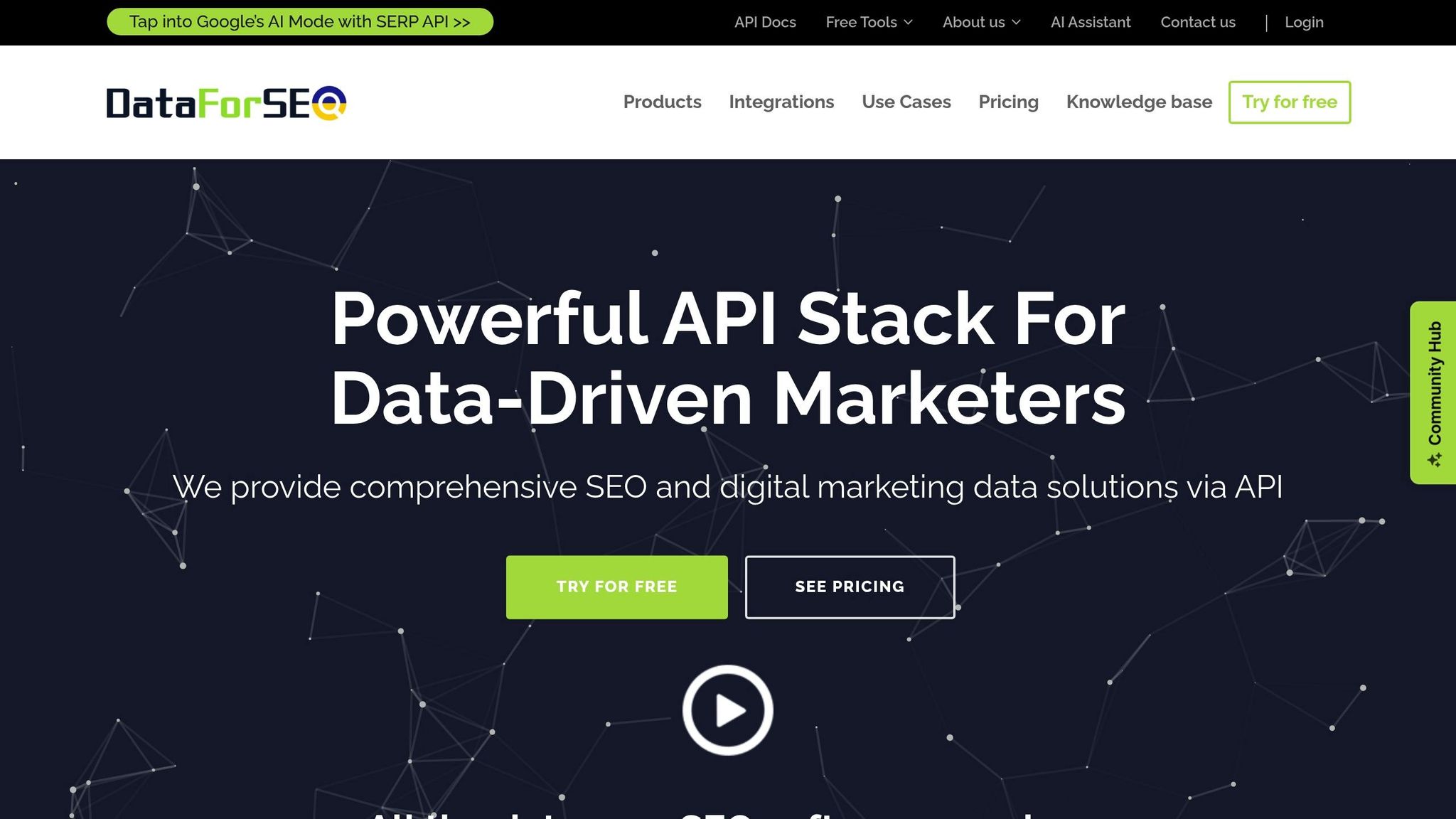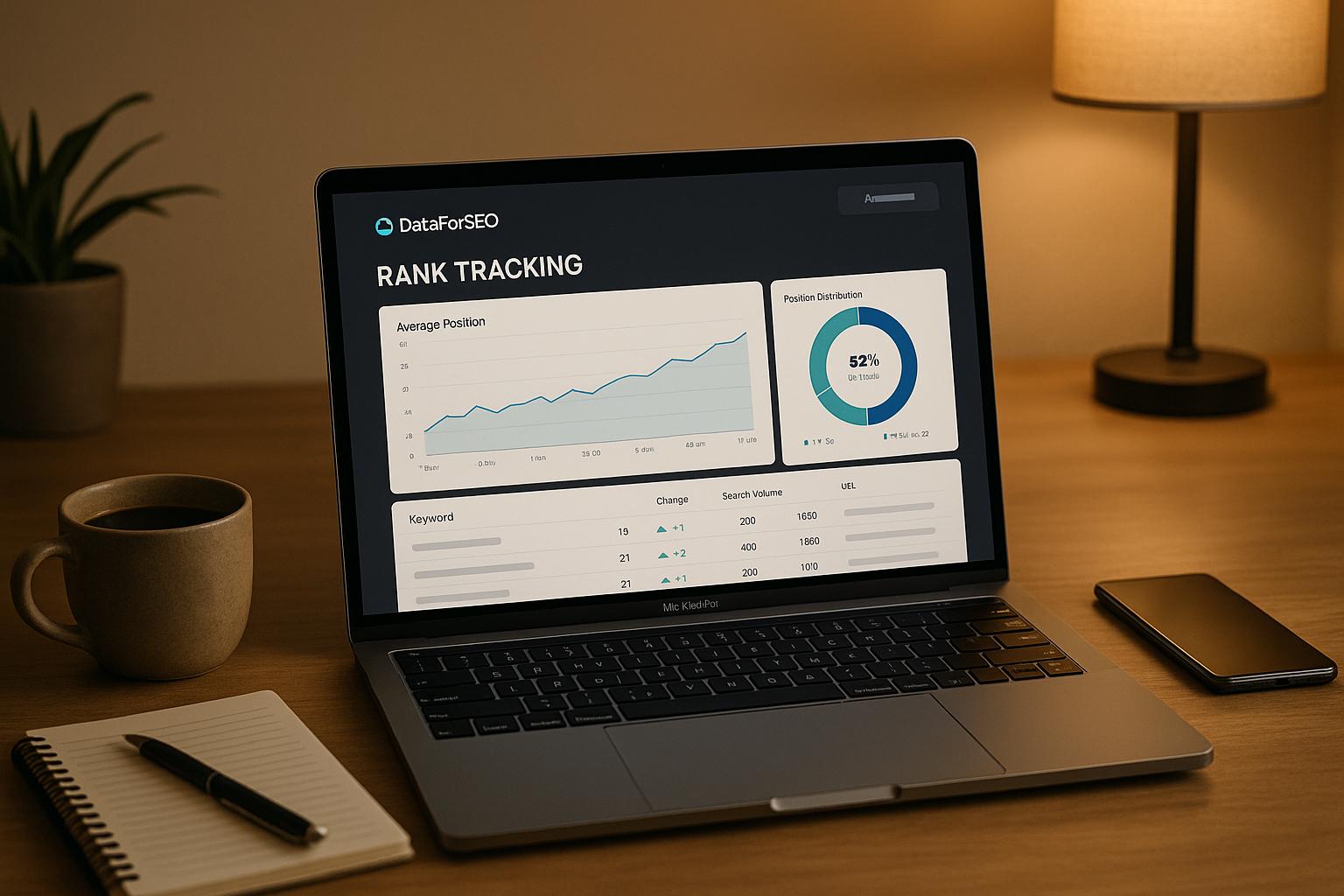Want to track keyword rankings effectively? The DataForSEO API simplifies rank tracking with precise, real-time data from over 7 billion keywords and 100,000+ global locations. It’s designed for SEO professionals who need accurate insights without overspending.
Here’s what you’ll learn:
- What DataForSEO API does: Tracks rankings, analyzes trends, and supports SEO dashboards.
- Key features: Pay-as-you-go pricing, multiple endpoints (SERP, Labs, Keyword Data, OnPage), and support for popular programming languages like Python and PHP.
- How to get started: Create an account, retrieve API credentials, and configure endpoints for tracking.
- Practical tips: Use live or standard methods for data retrieval, optimize API costs, and integrate results into custom dashboards.
Pro tip: Whether you’re tracking a few keywords or thousands, DataForSEO offers flexible options to suit your needs. Let’s dive into the details.
Setting Up DataForSEO API

Creating an Account and Retrieving API Credentials
Getting started with DataForSEO is quick and straightforward. Begin by creating an account to access your API credentials.
First, head over to the DataForSEO website and sign up for a free trial account. This trial includes a $1 account balance, allowing you to test the APIs and explore their features before committing to a paid plan. During registration, you’ll use your email address, which also serves as your API login.
Once your account is ready, your API credentials are automatically generated. These credentials include your API login (your registered email) and a secure API password, which is different from your regular account password.
To locate your credentials, visit the API Access Dashboard in your account. Here, you’ll find both your API login and password. Keep in mind, the API password becomes hidden after 24 hours for security reasons. If you lose it, you can request a new one through the email tied to your account.
Make sure to save your credentials securely right after creating the account. Using a password manager or storing them in a secure configuration file is a smart move since you’ll need them for every API request.
Once your credentials are safe, check that your development environment meets the requirements for API integration.
System Requirements and Tools
The DataForSEO REST API is designed to work with nearly any programming environment, but some tools and languages provide added convenience and support.
Supported Programming Languages:
DataForSEO offers officially supported client libraries for PHP, Python, C#, Java, and TypeScript. These libraries come with pre-built functions and error-handling features, which can save you a lot of development time. For instance, the Python client library automatically manages authentication, request formatting, and response parsing, while the PHP client provides built-in methods for major API endpoints.
Development Environment Setup:
Your system should be capable of processing JSON data and handling HTTP requests. When making POST requests, ensure your environment sends data in JSON format with UTF-8 encoding. Most modern programming languages handle this natively, but double-check that special characters are processed correctly.
No-Code Options:
Prefer a visual approach? DataForSEO integrates with no-code platforms like Make, Airtable, and Zapier. These platforms let you build automated workflows, such as pulling daily ranking data and updating a Google Sheets dashboard.
Node.js Requirements:
For more advanced setups, like using the DataForSEO Community Node in n8n or deploying the DataForSEO MCP server, you’ll need Node.js. For optimal performance, ensure you’re using the latest version of Node.js.
"DataForSEO offers detailed documentation for every parameter, field, and function you’ll encounter while using our APIs and databases."
Testing Tools:
Tools like Postman are invaluable for testing endpoints, verifying responses, and troubleshooting authentication issues before moving your integration to production.
Once your tools are ready, the next step is configuring secure API authentication.
API Authentication Methods
DataForSEO employs Basic Authentication to securely manage API requests.
How It Works:
Every API request must include your credentials in the Authorization header, formatted like this:
Authorization: Basic login:password
Before sending, the "login:password" combination needs to be Base64-encoded. For example, if your email is user@example.com and your API password is abc123, combine them as user@example.com:abc123 and encode the string in Base64.
Security Best Practices:
To protect your credentials, DataForSEO does not allow them to be passed through URL parameters. Always include them in the Authorization header to prevent exposure in server logs or browser history.
No Token Requests Needed:
Unlike some APIs, DataForSEO doesn’t require a separate call to obtain a token. You simply include your encoded credentials with each API request.
Implementation Advice:
Store your Base64-encoded credentials as environment variables instead of hardcoding them. This approach improves security and simplifies management across different environments, such as development, staging, and production.
Most programming languages have built-in functions for Base64 encoding. For example, Python includes the base64 module, and JavaScript offers the btoa() function. If you’re using one of DataForSEO’s official client libraries, the encoding is handled automatically, making integration even easier.
Testing Your Authentication:
Before diving into your full integration, test your authentication with a simple API call, like a ping service, to ensure your credentials are working and to catch any issues early.
"Regardless of the programming language, your unique API token should be passed in the ‘Authorization’ header within the request in the following format: Authorization: Basic login:password"
DataForSEO APIs: Developer’s Quick Start Guide| w/ PHP example walkthrough 🔥
Configuring DataForSEO API Endpoints
Once your account is set up and API authentication is complete, the next step is configuring endpoints to track rankings effectively.
Key Rank Tracking Endpoints
DataForSEO offers several API options to streamline rank tracking and analysis.
- SERP API: This provides real-time ranking positions for your target keywords across various search engines and locations. Over the past 30 days, it has updated an impressive 336,850,908 SERPs.
- DataForSEO Labs API: Ideal for historical analysis and competitive insights, this endpoint tracks 5,515,406,315 keywords, also updated in the last 30 days. It’s perfect for uncovering long-term ranking trends.
- On-Page API: While not focused on rankings, this API evaluates technical SEO factors, identifying areas for improvement that could enhance performance.
- Keyword Data API: This delivers crucial metrics like search volume, competition levels, and related keyword suggestions, helping you discover new opportunities and contextualize your ranking data.
For most scenarios, the SERP API is your go-to for current rankings, while the Labs API provides historical trends. Together, they offer a comprehensive view of your SEO performance over time.
Next, let’s dive into the two approaches for retrieving SERP data: live and standard methods.
Live vs. Standard SERP API Methods
DataForSEO provides two ways to retrieve SERP data, tailored to different needs.
- Live Method: This option delivers instant results within a single API call, typically within 6 seconds. It’s the best choice for real-time dashboards or quick checks when speed is critical.
- Standard Method: This method involves separate POST and GET requests, making it more cost-efficient for large-scale operations. You submit tasks first, then retrieve results once processing is complete. It also offers Normal and High priority options, allowing you to balance speed and cost.
Here’s a quick comparison:
| Feature | Live Method | Standard Method |
|---|---|---|
| Request Structure | Single API call | Separate POST and GET |
| Speed | Instant (up to 6 sec) | Varies by priority level |
| Cost | Higher per request | More affordable at scale |
| Best For | Real-time needs | Batch processing, scale |
| Scalability | Limited by timeouts | Highly scalable |
Many large-scale users prefer the Standard method with High priority for its balance of speed and cost.
Additionally, the Standard method supports pingback URLs, which notify your system when results are ready, eliminating the need for constant polling.
Use the Live method for interactive tools requiring instant feedback, and opt for the Standard method for handling thousands of keywords daily – where cost savings can add up significantly.
Setting API Request Parameters
Once you’ve chosen your API method, the next step is fine-tuning the request parameters to ensure accurate and relevant data output.
Key parameters include:
keyword,target, andtag: Use these to focus on specific domains, subdomains, or pages. For example, thetargetparameter fetches data exclusively for your specified domain or webpage.location_nameorlocation_code: These parameters help you track rankings in specific geographic markets.language_name: Ensures results are captured in the appropriate language variant.pingback_url: Automatically sends results to your server, enabling real-time updates without manual retrieval.
Here’s an example of a properly configured POST request for tracking a specific domain:
POST https://api.dataforseo.com/v3/serp/google/organic/task_post
[
{
"language_name": "English",
"location_name": "United States",
"keyword": "albert einstein",
"tag": "wikipedia.org",
"pingback_url": "https://your-server.com/pingback.php?id=$id"
}
]
For historical trends using the Labs API, include the date_from and date_to parameters to define the time range. Combine this with your target domain and location to retrieve metrics like estimated traffic volume (ETV), which illustrate ranking changes over time.
Finally, keep in mind that parameter choices directly impact your costs. With SERP API pricing ranging from $0.0006 to $0.002 per SERP, selecting the right combination of location specificity, update frequency, and data depth can help you manage expenses effectively. DataForSEO’s pay-as-you-go model ensures you only pay for what you use.
Integrating DataForSEO API into SEO Dashboards
Now that your endpoints are set up, it’s time to bring the DataForSEO API into your SEO dashboard. This involves three main steps: submitting rank tracking tasks, retrieving the results, and storing the data for ongoing use.
Submitting Rank Tracking Tasks
To capture ranking data, submit rank tracking tasks using POST requests. The request body should be in JSON format and include all necessary parameters, such as keywords, domains, locations, and language preferences.
Here’s an example of a POST request:
POST https://api.dataforseo.com/v3/serp/google/organic/task_post { "keyword": "SEO dashboard tools", "location_name": "United States", "language_name": "English", "target": "searchxpro.com/", "tag": "dashboard_tracking_001", "pingback_url": "https://your-dashboard.com/api/pingback" } The "tag" parameter is especially helpful for organizing different campaigns or projects. For instance, you can use tags like "client_a_brand_terms" or "competitor_analysis_q4" to keep things organized. Remember to use the correct HTTP method – POST for submitting tasks and GET for retrieving results.
Once tasks are submitted, you’ll need to retrieve and parse the API responses to make the data actionable.
Retrieving and Parsing API Responses
After submitting tasks, the next step is to fetch and process the JSON responses. For live methods, results are returned immediately in the same API call.
The response typically contains:
- Task metadata: Includes cost, processing time, and status codes.
- SERP results: Provides ranking positions, URLs, and competitor data.
- Metrics: Covers search volume, competition levels, and estimated traffic.
- Historical data: Available for trend analysis when using Labs API endpoints.
Here’s an example of a response:
{ "status_code": 20000, "status_message": "Ok.", "time": "2.1 sec.", "cost": 0.001, "tasks": [ { "id": "12071934-1535-0406-0000-81ea4df500b6", "result": [ { "keyword": "SEO dashboard tools", "location_code": 2840, "items": [ { "type": "organic", "rank_group": 1, "rank_absolute": 1, "position": "left", "domain": "searchxpro.com/", "title": "Best SEO Dashboard Tools...", "url": "https://searchxpro.com/seo-dashboard-tools" } ] } ] } ] } For Standard tasks, save the task ID from the response and use GET requests to retrieve completed results later. Make sure your parsing logic can handle different scenarios, including errors. If a request fails, refer to the Errors documentation for non-20000 status codes. Focus on extracting key details like rank_absolute, domain, and URL data.
Once the data is parsed, the next step is to store it securely and ensure it updates automatically.
Storing and Automating Rank Data
To track real-time and historical trends effectively, you’ll need to store rank data and automate its updates.
Database Design Tips
Set up your database to handle both current rankings and historical trends. A typical schema might include tables for keywords, domains, daily rankings, and API task logs. Ensure API credentials are stored securely, and monitor API usage to manage costs.
Here’s an example of a rankings table structure:
| Field | Type | Purpose |
|---|---|---|
keyword_id |
INT | Links to the keywords table |
domain |
VARCHAR | The domain being tracked |
position |
INT | Current SERP ranking |
date_tracked |
DATE | Date the ranking was captured |
location_code |
INT | Geographic market |
task_id |
VARCHAR | Reference to the API task |
Automation Strategies
Schedule tasks to track rankings at consistent intervals. While daily tracking is common, weekly or bi-weekly schedules can help manage costs. Batch queries whenever possible – for instance, group 50-100 keywords in a single API call to reduce rate limits and costs. Log any failed API calls for troubleshooting later.
Ensuring Data Quality
To maintain consistency, standardize keywords by converting them to lowercase and removing punctuation before storing them. Track ranking changes over time to identify trends and performance shifts. Implement error-handling mechanisms for issues like API outages or invalid keywords, and store failed requests separately to retry during off-peak hours.
For easier API integration, DataForSEO provides client libraries for PHP, Python, C#, Java, and TypeScript. These libraries handle authentication, request formatting, and basic error handling, allowing you to focus on building your dashboard logic.
Visualizing and Analyzing Rank Data
Once you’ve stored your rank data, the next step is turning those numbers into actionable insights. The goal is to transform raw DataForSEO API outputs into meaningful information that helps your team make informed decisions.
Mapping API Data to Dashboard Metrics
The first step is to map the data from API responses to metrics that matter on your dashboard. Keep your dashboard focused by limiting it to 5–7 core metrics. From the DataForSEO API, you can extract critical details like current rankings (via rank_absolute), page-specific information (such as domain and url), and geographic performance (using location_code).
Instead of simply listing raw rankings, convert them into key performance indicators (KPIs). For instance, you can calculate search visibility scores by combining ranking positions with search volume data. Another useful visualization is a ranking distribution chart, which shows how many keywords fall into position ranges like 1–3, 4–10, or 11–20.
When it comes to visualizations, choose the right format for the story you’re telling:
- Line charts for trends over time
- Bar charts for comparisons
- Gauge charts for progress tracking
Layer your dashboard information so technical teams can dive into details while executives see a high-level summary. To make your analysis even more insightful, integrate both historical trends and real-time updates.
Using Historical and Real-Time Data
Combining historical data with real-time updates provides a complete picture, helping you spot long-term trends while reacting to immediate changes.
Historical data can highlight seasonal trends and the impact of algorithm updates. For example, analyzing keyword performance over time can help you separate meaningful patterns from random noise. This insight is especially valuable for planning content strategies. If an e-commerce client’s rankings consistently rise in November and December, you can prepare optimization campaigns well in advance.
Real-time data, on the other hand, allows for quick responses. Set up alerts for major ranking shifts – like dropping from page 1 to page 2 – or for unexpected improvements. Logging site changes alongside ranking data can help you connect the dots between updates and performance shifts.
By analyzing trends over multiple periods, you can avoid overreacting to random fluctuations. For instance, an e-commerce site once saw a 12-position ranking improvement over three months, leading to a 67% traffic increase – a result of focusing on consistent, data-driven strategies. This kind of analysis is essential for keeping your SEO dashboard relevant and responsive.
Managing API Costs and Query Optimization
Effective visualization isn’t just about the data – it also requires managing API costs wisely. The DataForSEO API can become expensive if not optimized, so it’s essential to plan your queries carefully.
One cost-saving approach is batching keywords into a single API call. This reduces both expenses and rate limit issues while maintaining data accuracy. Focus on high-value keywords by tracking them more frequently, and schedule less frequent updates for long-tail terms.
Choose between Live and Standard API methods based on your needs. Live methods are ideal for urgent monitoring and competitive analysis, while Standard methods are more budget-friendly for routine tracking. Scheduling API calls during off-peak hours can help avoid rate limits and further reduce costs.
Regularly review your API usage to identify which keywords or locations consume the most credits. For example, a local business might not need to track rankings across every major city. Periodic dashboard reviews and user feedback can help fine-tune your approach, ensuring your resources are directed toward the most impactful tracking activities.
Conclusion and Next Steps
Key Takeaways
Using the DataForSEO API simplifies rank tracking by giving businesses access to an enormous pool of live data and keywords at a low cost. Thanks to its pay-as-you-go model, companies of all sizes can benefit. For instance, one user reported spending just $2 out of a $50 starting credit after months of testing. With access to over 7.4 billion tracked keywords and 214 trillion live backlinks, the platform offers a massive resource for SEO professionals.
The automation features make data collection effortless, freeing up time for deeper analysis. Tools like batching, scheduling, and error-handling help create reliable dashboards that deliver consistent insights without straining your budget. Plus, the choice between Live and Standard API methods allows you to balance speed and cost based on your specific goals.
"DataForSEO has turned out to be a solid choice for pulling SEO insights without unnecessary overhead. It’s flexible, easy to integrate, and cost-effective." – Chris Lever
With a 4.8 out of 5-star rating on Capterra and frequent praise for its ease of use and customer service, DataForSEO is a dependable option. The platform’s 336,850,908 SERP updates in the past 30 days ensure your data reflects the latest search trends.
These tools and insights set the stage for more strategic SEO efforts, which are explored further below.
Additional Resources and Support
To maximize the value of DataForSEO’s API, pairing it with expert SEO guidance can elevate your rank tracking efforts. Combining the platform’s data capabilities with strategic planning ensures you’re not just collecting data – you’re turning it into actionable results.
SearchX specializes in scalable SEO strategies that complement DataForSEO’s strengths. Whether you’re focusing on keyword research, technical audits, or content optimization, their expertise ensures your rank tracking aligns with broader business goals. They also offer tailored solutions for platforms like Shopify, local SEO campaigns, and industry-specific needs.
If you need help interpreting ranking data, refining your content strategy, or addressing technical SEO challenges, SearchX can provide the insights needed to achieve measurable outcomes.
"DataForSEO offers high quality APIs for Google ranking checks, keyword and competitor data. The API documentation is very readable and comprehensive. Best of all, everything works as advertised. The customer support is quick and helpful." – Andre, CEO
FAQs
What are the benefits of DataForSEO API’s pay-as-you-go pricing model for small businesses?
The pay-as-you-go pricing model gives small businesses a budget-friendly way to access SEO data. Instead of being locked into pricey monthly subscriptions loaded with unnecessary features, businesses are charged only for what they use.
This approach allows small businesses to stay in control of their spending, adjust usage as needed, and allocate funds toward other growth priorities. It’s a practical way to incorporate robust rank tracking tools into their SEO efforts without breaking the bank.
What are the benefits of using the Standard method instead of the Live method for retrieving SERP data with the DataForSEO API?
When it comes to managing SERP data, the Standard method is perfect if you’re looking to scale efficiently and keep costs down. It’s a smart choice for handling large numbers of requests over extended periods without breaking the bank.
Meanwhile, the Live method delivers results in real time, but it comes with higher costs and resource demands. This makes it ideal for situations where getting data instantly is absolutely necessary. For most automated rank tracking needs, the Standard method strikes a great balance between cost and performance.
How do I securely manage my API credentials when integrating the DataForSEO API into my SEO dashboard?
To keep your API credentials safe during integration, it’s crucial to follow these security practices:
- Secure storage: Always use encrypted storage solutions to keep your credentials safe. Avoid embedding them directly in your code, as this can expose them to unnecessary risks.
- Regular key rotation: Change your API keys periodically to reduce the impact of potential leaks or unauthorized access.
- Limit access: Apply strict, role-based permissions to ensure that only the right people or systems can access sensitive data.
- Server-side authentication: Opt for secure methods like JSON Web Tokens (JWT) to handle authentication, keeping credentials away from client-side exposure.
- Active monitoring: Set up logging and monitoring systems to quickly identify and respond to suspicious activity.
Taking these steps helps protect your API credentials and ensures the security of your SEO dashboard integration.




